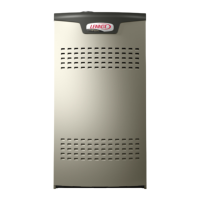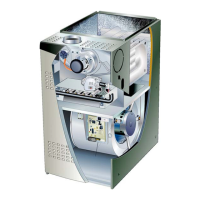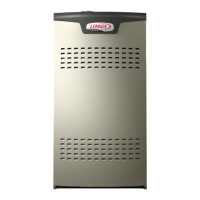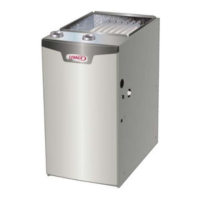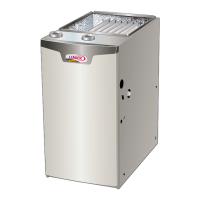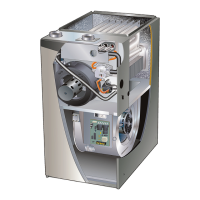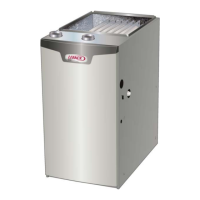Page 14
HORIZONTAL RIGHT POSITION
Top Vent Discharge
Gas supply piping must be brought into the unit from the bottom
in order to accommodate the flue pipe.
Remove make-up box assembly (2 screws) and cut wire tie to
free make-up box wires. Re-install make-up box on other side
of cabinet.
Re-secure make-up box wires by either pulling excess wires
through the blower compartment and securing with supplied
wire tie, or coil excess wire and secure to the gas manifold.
FLOW
AIR
flue transition
vent pipe
pressure switch
cover plate
make-up box
collector box
Figure 20
HORIZONTAL RIGHT POSITION
Side Vent Discharge - no modifications necessary
FLOW
AIR
Pressure Switch
Flue Transition
Collector Box
Make-Up Box
Vent Pipe
Figure 21
The EL180UHE series units are classied as fan-assisted
Category I furnaces when vertically vented according to
the latest edition of National Fuel Gas Code (NFPA 54 /
ANSI Z223.1) in the USA.
A fan-assisted Category I furnace is an appliance equipped
with an integral mechanical means to either draw or force
combustion products through the combustion chamber
and/or heat exchanger. The EL180UHE is not approved
for use with horizontal venting.
NOTE - Use these instructions as a guide. They do not su-
persed local codes. This funace must be vented according
to all locawl codes these installation instructions, and the
provided venting tables in these instructions
The venting tables in this manual were extracted from the
National Fuel Gas Code (NFPA 54 / ANSI Z223.1) and are
provided as a guide for proper vent installation. Proper
application, termination, construction and location of vents
must conform to local codes having jurisdiction. In the ab-
sence of local codes, the NFGC serves as the dening
document.
Use self-drilling sheet metal screws or a mechanical fas-
tener to rmly secure the vent pipe to the round collar of
the ue transition. If self-drilling screws are used to attach
the vent pipe, it is recommended that three be used. Drive
one self-drilling screw through the front and one through
each side of the vent pipe and collar. See gure 22.
Install the rst vent connector elbow at a minimum of six
inches (152 mm) from the furnace vent outlet. See gure
22.
Venting Using a Masonry Chimney
The following additional requirements apply when a lined
masonry chimney is used to vent this furnace. Masonry
chimneys used to vent Category I central furnaces must
be either tile-lined or lined with a listed metal lining sys-
tem or dedicated gas vent. Unlined masonry chimneys are
prohibited. See gures 23 and 24 for common venting.
A chimney with one or more sides exposed to the outside
of the structure is considered to be an exterior chimney.
An exterior masonry chimney that is not tile-lined must be
lined with B1 vent or a listed insulated exible metal vent.
An exterior tile-lined chimney that is sealed and capped
may be lined with a listed uninsulated exible metal vent.
If the existing chimney will not accommodate a listed met-
al liner, either the chimney must be rebuilt to accommo-
date one of these liners or an alternate approved venting
method must be found.
Insulation for the exible vent pipe must be an encapsu-
lated berglass sleeve recommended by the exible vent
pipe manufacturer. See gure 23.
Refer to the tables and the venting information contained
in these instructions to properly size and install the venting
system.
IMPORTANT
Once the venting system is installed, attach the
“Disconnected Vent” warning sticker to a visible area
of the plenum near the vent pipe. See gure 22. The
warning sticker is provided in the bag assembly. Order
kit 66W04 for additional stickers..

